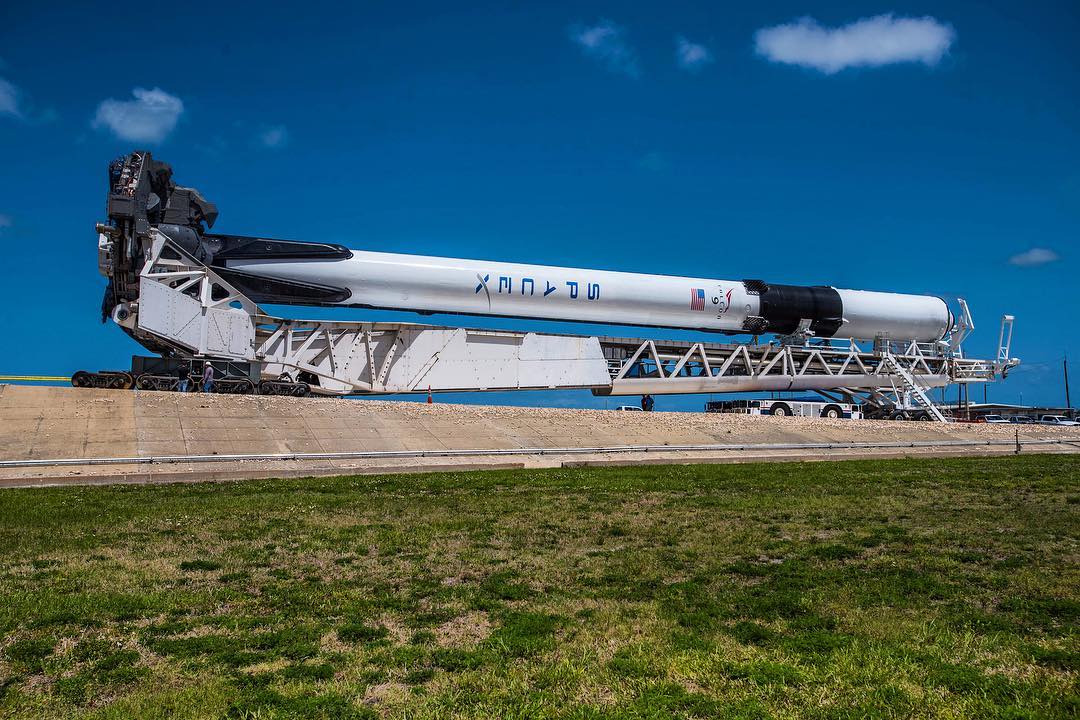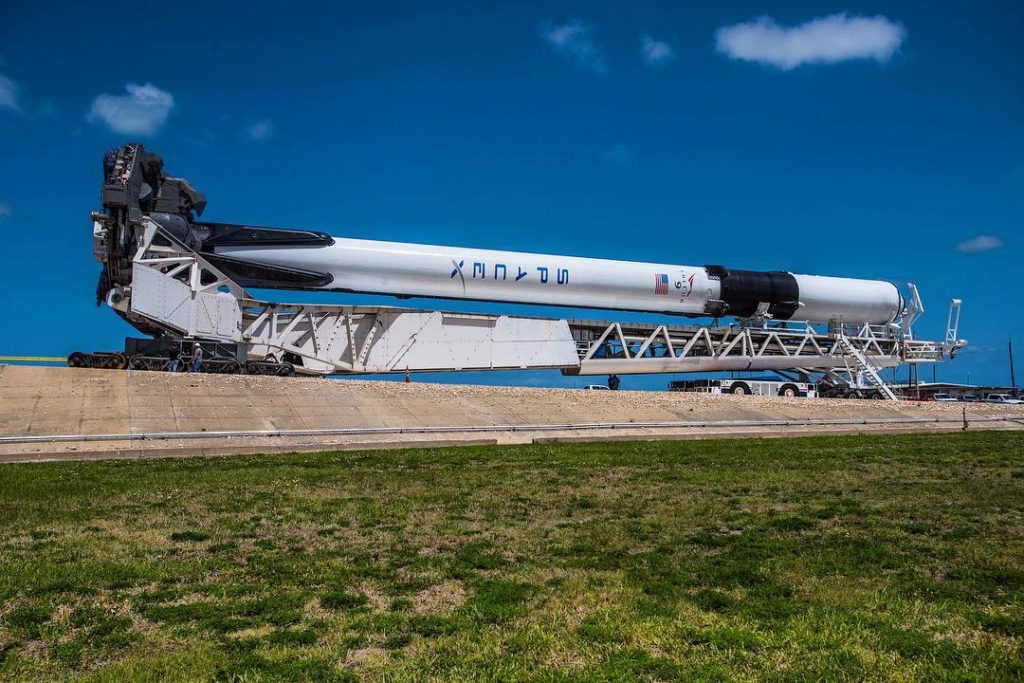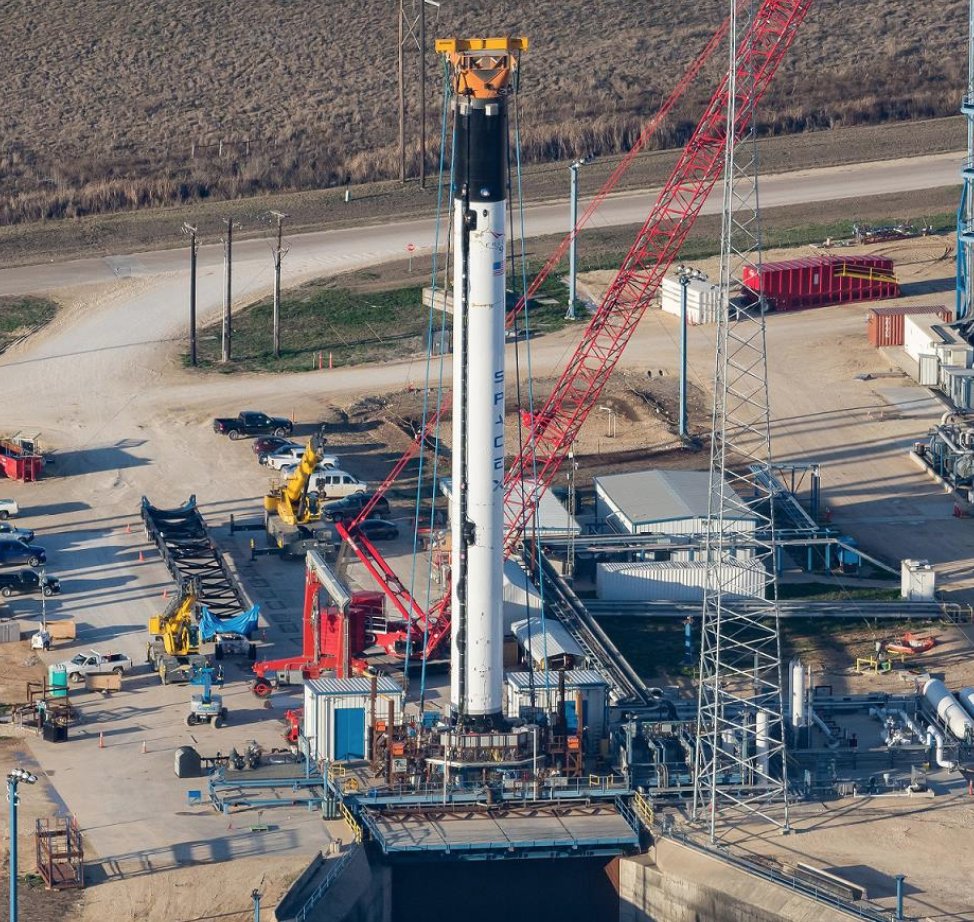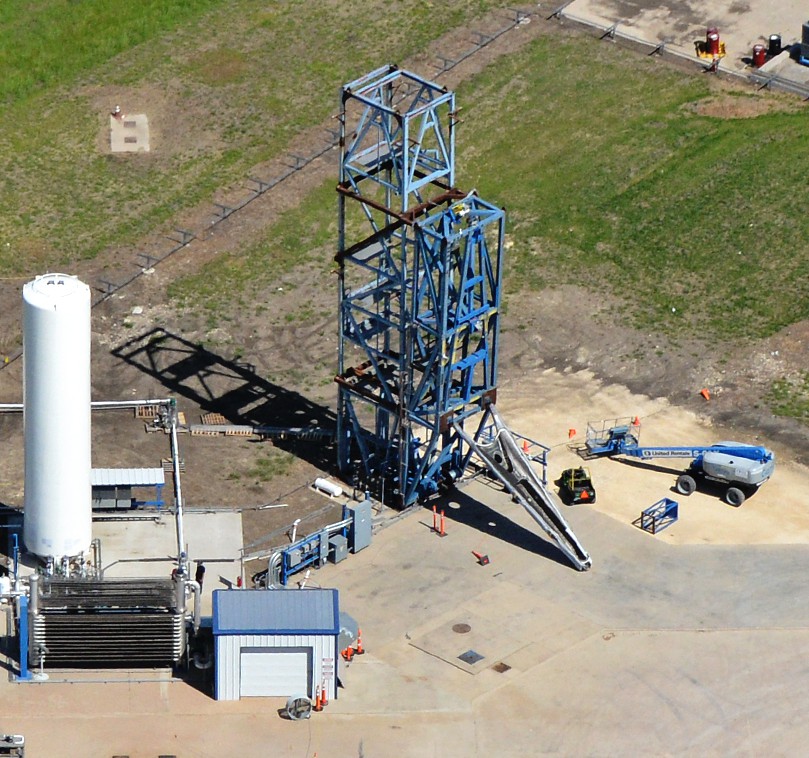

News
Elon Musk shows off SpaceX’s Falcon 9 Block 5 ahead of launch and landing debut
SpaceX CEO Elon Musk has published what appears to be the first official photo of the company’s newest Falcon 9 upgrade, known as Block 5. This particular booster is the first Falcon 9 Block 5 to be shipped to SpaceX’s launch facilities and is currently aiming for its first launch sometime next week after a May 4 static fire test, perhaps its first of anywhere from 10 to 100 operational missions.
Designed with reliability and reusability front and center, the booster upgrades have focused on additional thermal protection around the octaweb and interstage, reusable legs capable of retracting after recovery, titanium grid fins, and dramatic improvements to the heatshield at the base of the rocket. On the reliability side of upgrades, SpaceX has completed dozens of Merlin 1D static fires to qualify a turbopump redesign requested by NASA, as well as an upgraded COPV designed to guard against the type of anomaly that catastrophically destroyed Amos-6 and Falcon 9 in September 2016. A huge amount of work has also been done to improve and redesign aspects of Falcon 9 for easier (and cheaper) production and refurbishment, most notably replacing the welded octaweb structure with a bolted alternative likely to relieve many headaches and many days of octaweb weld checks.
- Falcon 9 B1046 rolled out to the launch pad for the first time ever on May 3rd, 2018. (SpaceX)
- SpaceX Block 5 Falcon9 at McGregor, Texas [Credit: Chris G – NSF via Twitter, Reprinted with permission from NASASpaceflight.com]
Aside from the biggest and most obvious changes, Block 5 is host to dozens or hundreds of additional tweaks and updates, a reflection of SpaceX’s pursuit of continuous improvement. Per SpaceX’s Vice President of Manufacturing Andy Lambert, SpaceX has “never built any two vehicles identically”, and Block 5 continues that tradition. Many Block 5 features have, however, already been flight-tested and optimized on previous Block 4 launches, including the octaweb heatshield, titanium gridfins, and minor aerodynamic tweaks to the second stage.
Block 5 sitting on the pad – harsh late day lighting [6341x 2804]
by inSpaceXLounge
The rocket is set to conduct its inaugural launch sometime next week – although the current schedule has SpaceX on May 7, Bangladeshi media have indicated that that date will slip a few days to the right after a handful of delays to the booster’s static fire. Tasked with lofting the country’s first geostationary communications satellite, Bangabandhu-1, B1046 will carry the 3500 kg spacecraft on its way to a high-energy geostationary transfer orbit before separating from the second stage and heading back to earth. The drone ship ‘Of Course I Still Love You’ and tugboat Rachel were spied departing from Port Canaveral at around the same time as Falcon 9 rolled out, and they will travel several hundred miles into the Atlantic to catch the pathfinder booster.
Tug boat Rachel has left Port Canaveral with OCISLY ahead of the SpaceX Bangabandhu mission on May 7th. The launch will be the first to feature a Block V Falcon 9.
— Michael Baylor (@MichaelBaylor_) May 3, 2018
Teslarati photographer Tom Cross will be on hand to capture the historic rocket’s static fire and launch over the next week or so, as well as the first Block 5 recovery on OCISLY if all goes as planned. Failure is always a possibility when flight-testing significantly upgraded technological systems, rockets especially, but SpaceX likely has far less tolerance for failure in the case of Block 5 – any problems with the rocket will almost invariably mothball into NASA concerns and investigations as the company nears its first crewed launches. Fingers crossed for the successful inaugural launch and landing of Falcon 9 Booster 1046.
- SpaceX’s second Falcon 9 Block 5 booster was spied by an aerial photographer in Texas, April 17. (Aero Photo)
- The same April 2018 flight captured what appears to be a Block 5 landing leg undergoing testing at a specially-designed test stand. (Aero Photo)
Follow us for live updates, behind-the-scenes sneak peeks, and a sea of beautiful photos from our East and West coast photographers.
Teslarati – Instagram – Twitter
Tom Cross – Twitter
Pauline Acalin – Twitter
Eric Ralph – Twitter

News
Tesla Cybercab tests are going on overdrive with production-ready units
Tesla is ramping its real-world tests of the Cybercab, with multiple sightings of the vehicle being reported across social media this week.

Tesla is ramping its real-world tests of the Cybercab, with multiple sightings of the autonomous two-seater being reported across social media this week. Based on videos of the vehicle that have been shared online, it appears that Cybercab tests are underway across multiple states.
Recent Cybercab sightings
Reports of Cybercab tests have ramped this week, with a vehicle that looked like a production-ready prototype being spotted at Apple’s Visitor Center in California. The vehicle in this sighting was interesting as it was equipped with a steering wheel. The vehicle also featured some changes to the design of its brake lights.
The Cybercab was also filmed testing at the Fremont factory’s test track, which also seemed to involve a vehicle that looked production-ready. This also seemed to be the case for a Cybercab that was spotted in Austin, Texas, which happened to be undergoing real-world tests. Overall, these sightings suggest that Cybercab testing is fully underway, and the vehicle is really moving towards production.
Production design all but finalized?
Recently, a near-production-ready Cybercab was showcased at Tesla’s Santana Row showroom in San Jose. The vehicle was equipped with frameless windows, dual windshield wipers, powered butterfly door struts, an extended front splitter, an updated lightbar, new wheel covers, and a license plate bracket. Interior updates include redesigned dash/door panels, refined seats with center cupholders, updated carpet, and what appeared to be improved legroom.
There seems to be a pretty good chance that the Cybercab’s design has been all but finalized, at least considering Elon Musk’s comments at the 2025 Annual Shareholder Meeting. During the event, Musk confirmed that the vehicle will enter production around April 2026, and its production targets will be quite ambitious.
News
Tesla gets a win in Sweden as union withdraws potentially “illegal” blockade
As per recent reports, the Vision union’s planned anti-Tesla action might have been illegal.

Swedish union Vision has withdrawn its sympathy blockade against Tesla’s planned service center and showroom in Kalmar. As per recent reports, the Vision union’s planned anti-Tesla action might have been illegal.
Vision’s decision to pull the blockade
Vision announced the blockade in early December, stating that it was targeting the administrative handling of Tesla’s facility permits in Kalmar municipality. The sympathy measure was expected to start Monday, but was formally withdrawn via documents sent to the Mediation Institute and Kalmar Municipality last week.
As noted in a Daggers Arbete report, plans for the strike were ultimately pulled after employer group SKR highlighted potential illegality under the Public Employment Act. Vision stressed its continued backing for the Swedish labor model, though Deputy negotiation manager Oskar Pettersson explained that the Vision union and IF Metall made the decision to cancel the planned strike together.
“We will not continue to challenge the regulations,” Petterson said. “The objection was of a technical nature. We made the assessment together with IF Metall that we were not in a position to challenge the legal assessment of whether we could take this particular action against Tesla. Therefore, we chose to revoke the notice itself.”
The SKR’s warning
Petterson also stated that SKR’s technical objection to the Vision union’s planned anti-Tesla strike framed the protest as an unauthorized act. “It was a legal assessment of the situation. Both for us and for IF Metall, it is important to be clear that we stand for the Swedish model. But we should not continue to challenge the regulations and risk getting judgments that lead nowhere in the application of the regulations,” he said.
Vision ultimately canceled its planned blockade against Tesla on December 9. With Vision’s withdrawal, few obstacles remain for Tesla’s long-planned Kalmar site. A foreign electrical firm completed work this fall, and Tesla’s Careers page currently lists a full-time service manager position based there, signaling an imminent opening.
News
Tesla Semi program Director teases major improvements

Tesla Semi Program Director Dan Priestly teased the major improvements to the all-electric Class 8 truck on Thursday night, following the company’s decision to overhaul the design earlier this year.
Priestley said he drove the Semi on Thursday, and the improvements appear to be welcomed by one of the minds behind the project. “Our customers are going to love it,” he concluded.
Just drove the redesigned Semi. Our customers are going to love it. https://t.co/KZ88sf1CDL
— Dan Priestley (@danWpriestley) December 19, 2025
The small detail does not seem like much, but it is coming from someone who has been involved in the development of the truck from A to Z. Priestley has been involved in the Semi program since November 2015 and has slowly worked his way through the ranks, and currently stands as the Director of the program.
Tesla Semi undergoes major redesign as dedicated factory preps for deliveries
Tesla made some major changes to the Semi design as it announced at the 2025 Annual Shareholder Meeting that it changed the look and design to welcome improvements in efficiency.
Initially, Tesla adopted the blade-like light bar for the Semi, similar to the one that is present on the Model Y Premium and the Cybertruck.
Additionally, there are some slight aesthetic changes to help with efficiency, including a redesigned bumper with improved aero channels, a smaller wraparound windshield, and a smoother roofline for better aero performance.
All of these changes came as the company’s Semi Factory, which is located on Gigafactory Nevada’s property, was finishing up construction in preparation for initial production phases, as Tesla is planning to ramp up manufacturing next year. CEO Elon Musk has said the Semi has attracted “ridiculous demand.”
The Semi has already gathered many large companies that have signed up to buy units, including Frito-Lay and PepsiCo., which have been helping Tesla test the vehicle in a pilot program to test range, efficiency, and other important metrics that will be a major selling point.
Tesla will be the Semi’s first user, though, and the truck will help solve some of the company’s logistics needs in the coming years.












